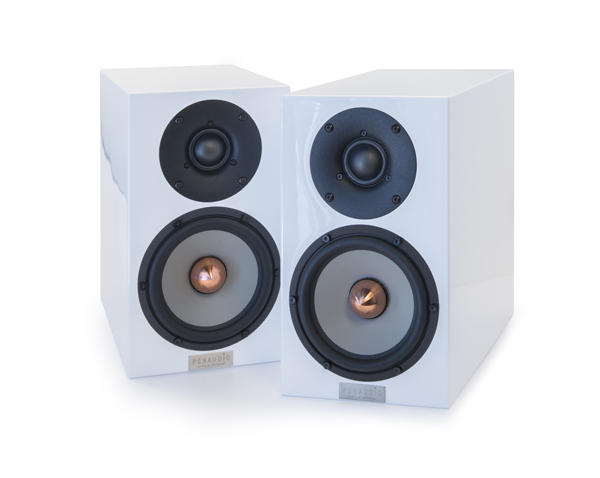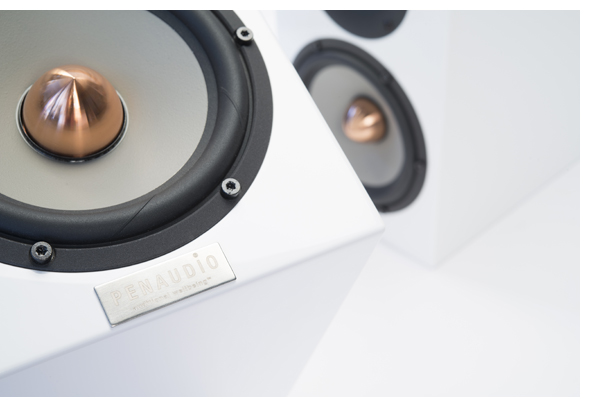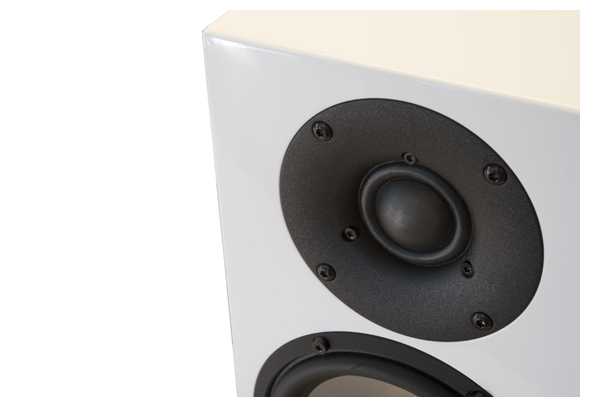Penaudio Cenya Monitors Miniature Masterpieces
By Jeff Dorgay Cranking Public Enemy’s “Fight the Power” to a level way beyond what I’d ever expect from a small pair of monitors causes me to redefine my mental short list for a final hi-fi system. While I routinely audition six-figure speakers (and enjoy every minute of it), the Cenya and its slightly more expensive sibling, the Cenya Signature, deliver so much music that I would happily retire with these Finnish beauties as destination speakers.
Cranking Public Enemy’s “Fight the Power” to a level way beyond what I’d ever expect from a small pair of monitors causes me to redefine my mental short list for a final hi-fi system. While I routinely audition six-figure speakers (and enjoy every minute of it), the Cenya and its slightly more expensive sibling, the Cenya Signature, deliver so much music that I would happily retire with these Finnish beauties as destination speakers.
The Cenyas do everything but deliver the last octave of deep bass, and at $4,000 a pair, they leave you enough scratch to add your favorite subwoofer, should you require it. But in a small- to medium-sized room, you may not need the extra bass. These speakers are positively heavenly in my new small listening room (10 by 13 feet) powered by the Devialet 120. Penaudio speakers have always needed a little bit of juice to give their all, and the 120 watts per channel provided by the Devialet gets the job done, no matter what the musical faire. The opening bass drum beats from Led Zeppelin’s “No Quarter” are delivered solidly, without overhang. As the cymbals linger in the air and fade off into black, the sparkle remains potent, which leads me to believe that these little speakers move some serious air.
It’s worth noting that Devialet owners that are running the current firmware can now take advantage of their new S.A.M. (Speaker Active Matching) system, which offers phase alignment for a list of speakers, like the Cenya, custom tailored to the individual speaker. S.A.M. also offers bass equalization/compensation in the DSP domain that extends the frequency response cleanly down to 25hz. This had just become available at the end of this review, so watch for a follow up when we’ve spent more seat time with it. The short story is that it works incredibly well. You’ll swear there is a subwoofer in the room!
My history with Penaudio goes way back to the Serenades that we reviewed in issue 4 and that ended up as my reference speakers for a couple years. I’ve always appreciated Penaudio founder Sami Pentilla’s ability to build speakers that combine understated good looks and natural tonality in a compact form. The tiny Cenya is no exception. It looks like a slice of the Serenade, with a 6-inch woofer and a 1.25-inch soft dome tweeter, and it is available in a wide variety of finishes.
This particular pair comes in the high-gloss white that was the rage at this year’s Munich High End show. Considering psychoacoustics, this may be the best color for these mini monitors, as it lets them disappear even further into my listening environment, which is painted Ralph Lauren Studio White. A knuckle rap demonstrates cabinet rigidity, which contributes to the speakers’ stellar bass response and freedom from cabinet-induced vibration.

Super Simple Setup
As with any high-quality pair of mini monitors, the Cenyas benefit from doing two things: placing them on massive stands and providing a solid coupling between the speaker and stand. Though not as attractive as the Cenyas deserve, a pair of 24-inch sand-filled Sound Anchor stands works perfectly, with a set of small Isonode feet ($19.95 for a set of 4; available from Bright Star Audio) providing an ideal mechanical interface.
The Cardas Clear Light speaker cables also work well with these speakers, but for those requiring a bit more zip and high-frequency extension, the Graditech speaker cables provide it. They prove a perfect match for the Conrad Johnson LP125sa power amplifier, while the Clear Light cables are a more balanced solution (for these ears, anyway) with the Devialet.
Final speaker placement takes about 15 minutes, with a bit of fine-tuning after the Cenyas have about two weeks of major break-in. Like all of the other Penaudio speakers we’ve auditioned, a good week’s worth of listening to dynamic music at moderate to high volume does the trick—though they do sound fabulous right out of the box.
Jah Wobble’s Japanese Dub leads the way into a long session of bass-heavy tracks that help define the low-frequency response of the Cenya2. The official specification is +/–3 dB from 45 to 28,000 Hz in an anechoic chamber, and thanks to a little bit of room gain, the Cenya 2s reproduce the 40 Hz test tone on my Stereophile Test CD with ease, though bass response falls off rapidly after this. For most musical material, this will rarely be an issue, considering the quality of the bass that the speakers produce. Again, this was all done without S.A.M. engaged on the Devialet.
A Nimble Performer
In a modest-sized room with first-class amplification, the Cenyas will spoil you. Thanks to their small front surface and high-quality SEAS tweeter, they throw an expansive soundstage that not only extends beyond the speaker boundaries but also past the wall boundaries.
When I revisit Springsteen’s The Wild, The Innocent & The E Street Shuffle, it’s a pleasure to hear the nuance in his young voice and, even though the recording is only mediocre, the coherence provided by this high-quality two-way speaker makes it come to life. As with the previous Cenya iteration, the new Cenya exhibits a transparency much like an ESL. The Hammond organ at the beginning of “Kitty’s Back” remains in the air, slightly above the speakers, lingering in the room as though through my Quad 57s, but with more punch and dynamics.
The Cenyas excel at keeping the musical pace intact. The rapid-fire drum beats in Blamstrain’s “Dog Song” stay solidly anchored in the middle of some dreamy synth riffs, while the deep bass line fills the listening room without blurring the spacey presentation, until the volume is turned up well beyond a reasonable level. This is the only limitation of these petite Finns: They can only move so much air, and when pushed past their limit, they compress rapidly. However, I think anyone demoing a pair of Cenyas for the first time will be surprised at just how loud this level is.
Of course, the vocal performance of these speakers is beyond reproach. Those preferring more audiophile faire will be highly satisfied at the deftness with which the Cenyas project both male and female vocals. Whether you love Tom Waits or Shelby Lynne, the speakers deliver the goods.

Compatibility
With a sensitivity rating of 86 dB, the Cenyas work better with more power, though in my small room, even the 25-watt-per-channel 845 SET amplifiers at my disposal prove adequate, albeit not able to push the speakers as far as the 120-wpc Devialet can.
Regardless, the Cenyas are very tube friendly in a way that my Serenedes never were. The McIntosh MC275, PrimaLuna DiaLogue Monoblocks and the new C-J LP120sa vacuum-tube amplifiers all work well with the Cenyas, delivering great dynamics, extended HF response and good damping of the woofer cones without issue.
The Cenyas are equally versatile with solid-state amplification, from about 35 wpc on up, proving a good match with the 35-wpc Naim Qute2, the 50-wpc Rega Brio-R and the 60-wpc Pass Aleph 5—all reasonably priced yet high-performance small solid-state amplifiers.
Surprisingly, the Cenyas are transported into another world with the 300-wpc Burmester 911 MK3 and the similarly powered Pass Xs 300 monoblocks, though it is hardly likely that someone would spend $30,000 to $80,000 on amplification for a $4,000 pair of speakers—though, if you do, these little beauties are up to the task.
The $4,000 Question
If you are looking for maximum performance with minimum footprint, look no further than the Penaudio Cenyas. They will do justice to whatever ancillary components you have at your disposal and they produce way more music than you would expect from a speaker this diminutive in size. Highly recommended.
Penaudio Cenya monitors
MSRP: $4,000 per pair
PERIPHERALS
| Digital Source | Devialet 120 Meridian Control 15 MacBook Pro |
| Analog Source | Thorens TD-124 SME 3009 tonearm Ortofon 2M Black cartridge |
| Amplification | Devialet 120 |
| Cable | Cardas Clear |



